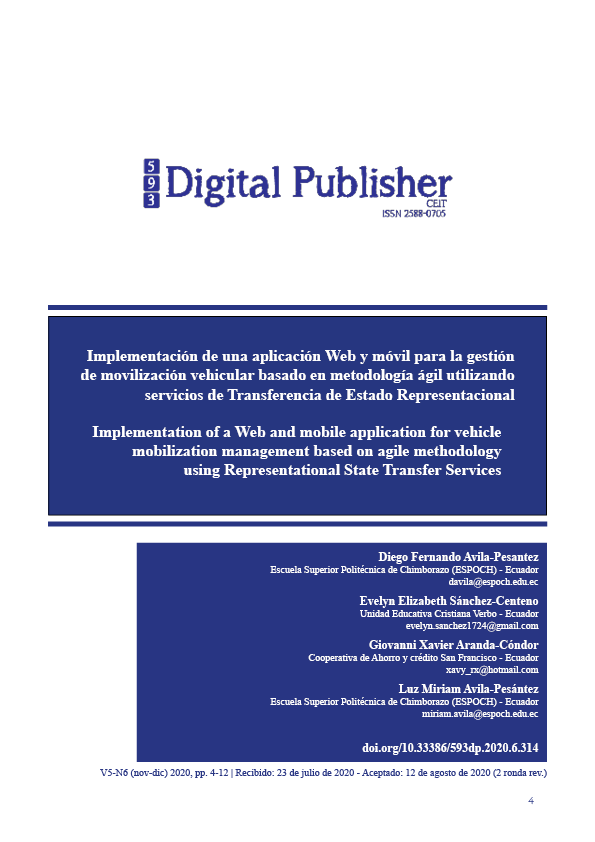Implementation of a Web and mobile application for vehicle mobilization management based on agile methodology using Representational State Transfer Services
Main Article Content
Abstract
Web and mobile application development is an important component within a modern organization, as it enables you to manage your processes efficiently. With this approach, this work details the analysis, design, and implementation of these applications for the management of more flexible and timely information in the control of vehicular mobilization that is managed by the Transport Management Unit of Escuela Superior Politécnica de Chimborazo (ESPOCH). The software was developed under the Scrum methodology and Representational State Transfer Services (REST), which allowed the development team and users to be adequately involved to design the necessary functionalities of the system. To evaluate the efficiency of the processes carried out by end-users, the response times of the old system versus the automated system were measured, significantly improving the management of these processes.
Downloads
Article Details

This work is licensed under a Creative Commons Attribution-NonCommercial-ShareAlike 4.0 International License.
1. Derechos de autor
Las obras que se publican en 593 Digital Publisher CEIT están sujetas a los siguientes términos:
1.1. 593 Digital Publisher CEIT, conserva los derechos patrimoniales (copyright) de las obras publicadas, favorece y permite la reutilización de las mismas bajo la licencia Licencia Creative Commons 4.0 de Reconocimiento-NoComercial-CompartirIgual 4.0, por lo cual se pueden copiar, usar, difundir, transmitir y exponer públicamente, siempre que:
1.1.a. Se cite la autoría y fuente original de su publicación (revista, editorial, URL).
1.1.b. No se usen para fines comerciales u onerosos.
1.1.c. Se mencione la existencia y especificaciones de esta licencia de uso.
References
Aguado, J.-M., Martínez, I. J., & Cañete-Sanz, L. (2015). Tendencias evolutivas del contenido digital en aplicaciones móviles. El profesional de la información, 24(6), 787-795.
Arroyave, M. H. T., & Cardona, D. (2012). Criterios de evaluación de plataformas de desarrollo de aplicaciones empresariales para ambientes web. Universidad Tecnológica de Pereira. Facultad de Ingenierías Eléctrica ….
Battle, R., & Benson, E. (2008). Bridging the semantic Web and Web 2.0 with representational state transfer (REST). Web Semantics: Science, Services and Agents on the World Wide Web, 6(1), 61-69.
Blanco, P., Camarero, J., Fumero, A., Werterski, A., & Rodríguez, P. (2009). Metodología de desarrollo ágil para sistemas móviles. Introducción al desarrollo con Android y el iPhone. Dr. en Ing. Sist. Telemáticos, 1-30.
Cáceres, P., Marcos, E., & Kybele, G. (2001). Procesos ágiles para el desarrollo de aplicaciones Web. Taller de Web Engineering de las Jornadas de Ingeniería del Software y Bases de Datos de, 2001.
Castillo, L. (2018). Resultados preliminares más significativos tras cuatro años de aplicación de la metodología SCRUM en las prácticas de laboratorio. ReVisión, 11(1), 5.
Cervone, H. F. (2011). Understanding agile project management methods using Scrum. OCLC Systems & Services: International digital library perspectives, 27(1), 18-22.
Contraloria. (2016). Reglamento General para la administración, utilización y control de los bienes y existencias del sector público de la Contraloría General del Estado. Retrieved from https://www.contraloria.gob.ec/documentos/normatividad/Acuerdo017-CG-2016Reglamentodebienes.pdf
Enriquez, J. G., & Casas, S. I. (2013). Usabilidad en aplicaciones móviles. Informes Científicos Técnicos-UNPA, 5(2), 25-47.
Fuentes, J. R. L. (2015). Desarrollo de Software ÁGIL: Extreme Programming y Scrum: IT Campus Academy.
Jung, H.-W., Kim, S.-G., & Chung, C.-S. (2004). Measuring software product quality: A survey of ISO/IEC 9126. IEEE software, 21(5), 88-92.
Khare, R., & Taylor, R. N. (2004). Extending the representational state transfer (rest) architectural style for decentralized systems. Paper presented at the Proceedings. 26th International Conference on Software Engineering.
López, L. M. A., Rivera, M. E. R., & Palomino, N. L. S. (2015). Análisis de aplicaciones empleando la computación en la nube de tipo PaaS y la metodología ágil Scrum. Industrial Data, 18(1), 149-160.
LUZURIAGA CAMACHO, J. E. (2013). La necesidad de incorporar en el reglamento sustitutivo para el manejo y administración de bienes del sector público, un capítulo que se refiera a las sanciones y clases de sanciones para la mala utilización de bienes del sector público por parte de los funcionarios de las instituciones del estado.
Martín, A. R., & Martín, M. J. R. (2014). Aplicaciones web: Ediciones Paraninfo, SA.
Pasini, A. C., Esponda, S., Boracchia, M., & Pesado, P. M. (2013). Q-Scrum: una fusión de Scrum y el estándar ISO/IEC 29110. Paper presented at the XVIII Congreso Argentino de Ciencias de la Computación.
Ríos, J. M., Mora, N. L., Ordóñez, M. Z., & Sojos, E. L. (2016). Evaluación de los Frameworks en el Desarrollo de Aplicaciones Web con Python. Revista Latinoamericana de Ingeniería de Software, 4(4), 201-207.
Schwaber, K. (1997). Scrum development process Business object design and implementation (pp. 117-134): Springer.
Smits, H., & Pshigoda, G. (2007). Implementing scrum in a distributed software development organization. Paper presented at the Agile 2007 (AGILE 2007).





